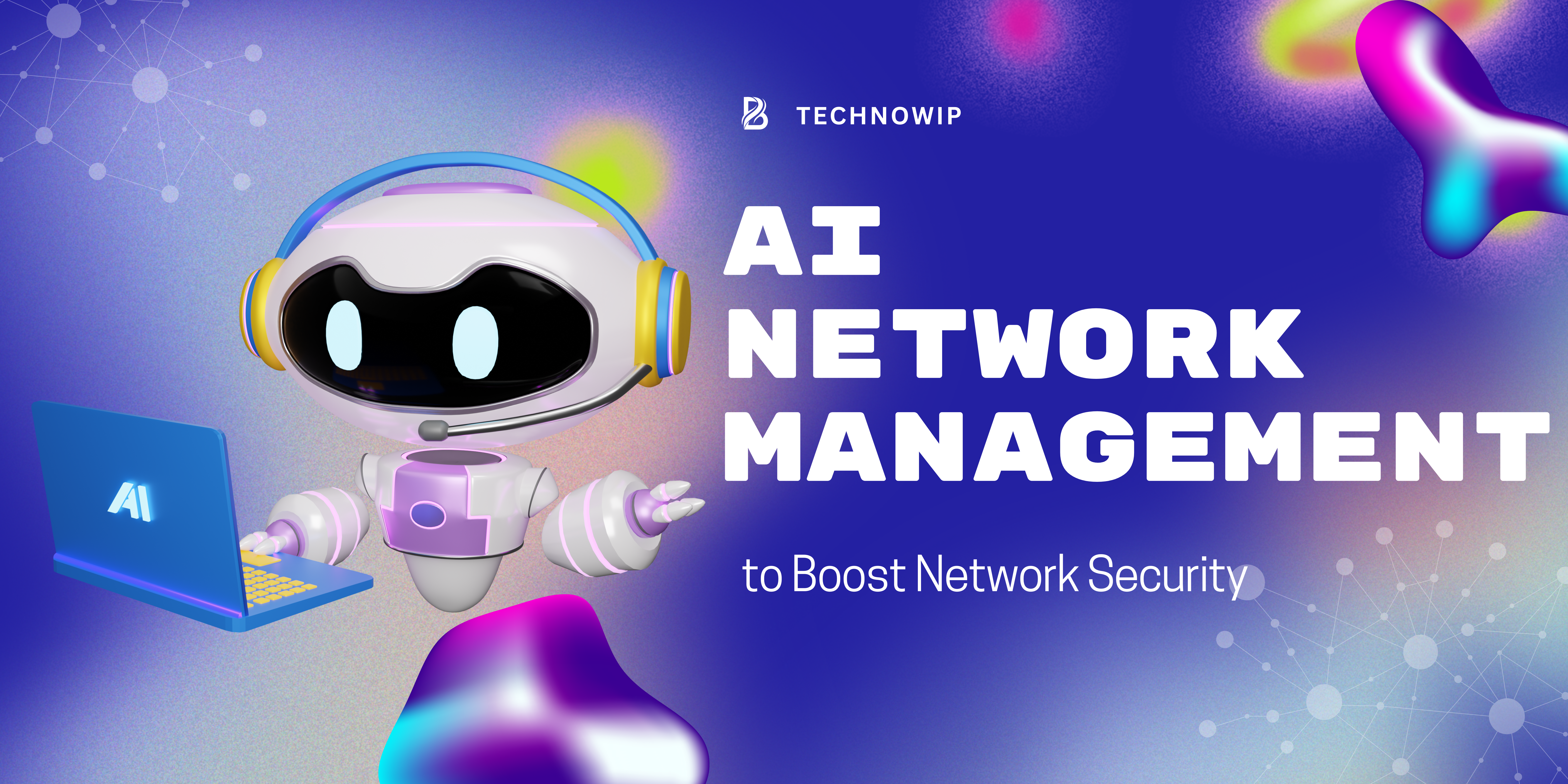Introduction
As networks expand in complexity and cyber threats evolve, organizations are turning toward AI-powered solutions for network management and security. AI has evolved beyond being seen as futuristic; instead it has revolutionized how companies manage, secure, and optimize their networks. In this blog we will look into how the PAS (Problem-Agitate-Solution) framework has transformed network security through AI network management solutions.
The Problem: Challenges in Traditional Network Management
1. Manual Processes and Human Error
- Network administrators rely heavily on manual tasks for configuration management, monitoring network traffic monitoring and threat detection – leaving room for human error which remains one of the primary sources of security breaches.
- Verizon found in 2023 that 74% of data breaches involving human error or improper credentials usage involved human components, including mistakes or misuse.
2. Lack of Real-Time Threat Detection
- Traditional security tools rely on static rules and signatures to detect threats, making it hard to respond immediately to new attack patterns in real time.
- Zero-day attacks often go undetected for days or even weeks, giving attackers plenty of time to cause irreparable harm to critical systems.
3. Overwhelming Volume of Alerts
- Security teams face a steady flow of alerts from various systems that prove false positives; manually managing such alerts eats up valuable time and resources.
- Ponemon Institute researchers recently conducted a poll and 49% of cybersecurity professionals who responded reported being overwhelmed with alerts that require action; consequently they have had to turn down most alerts as it becomes impossible for them to keep pace.
Agitation: Why These Issues Demand Immediate Attention
4. The Rising Threat of Cyber Attacks
- As ransomware attacks have skyrocketed 105% over the last two years, organizations face growing pressure to shore up their defenses against this growing threat.
- Attackers have turned to increasingly advanced attacks using sophisticated approaches – AI-powered malware is becoming a key weapon used by attackers against traditional security systems by constantly altering its behaviour, effectively bypassing them altogether.
5. Compliance and Regulatory Pressures
- Companies are required to abide by various data protection laws such as GDPR and HIPAA, making network security an imperative legal responsibility.
- Failing to secure networks can result in costly fines and reputational harm – in addition to data losses.
6. Limited Resources for Cybersecurity Teams
- Many organizations lack the funds and manpower required to hire large security teams, leaving existing security teams overwhelmed with tasks and limited in their ability to respond appropriately in an incident response situation.
- Small organizations are especially at risk due to a lack of funds to secure themselves with expensive tools or hire personnel for 24/7 monitoring services.
- At my early work with IT teams, I quickly understood the significance of effective network management. Our hours spent manually configuring systems became tedious as attackers found vulnerabilities quickly; that was when my curiosity about AI rose further.
Solution: AI-Powered Network Management for Security
7. What is AI Network Management?
- AI network management employs machine learning (ML) and artificial intelligence techniques to automate network operations, monitor traffic patterns and increase security.
- These systems utilize historical data to proactively address potential network performance or security threats before they have the chance to impact network operations or security.
8. Real-Time Threat Detection with AI
- AI-powered tools are capable of real-time traffic analysis, detecting unusual activity and flagging suspicious behaviour as it occurs – thus decreasing the chance for zero-day attacks.
- Cisco AI-based security solutions allow organizations to detect and mitigate threats 60% faster than with traditional tools.
9. Adaptive Security Policies
- AI can dynamically modify security policies based on changing network conditions, enabling networks to respond automatically to potential threats without waiting for human involvement.
- Tools such as Fortinet’s AI-driven firewall can alter access rules in response to user activity, providing constant protection.
AI-driven network tools were an eye-opener when I first explored them; their speed in detecting anomalies was remarkable. For instance, an AI system flagged a suspicious login attempt within seconds — something we would have taken hours to notice with traditional security methods alone. That experience cemented my admiration of how efficiently AI delivers security.
10. AI Reduces False Positives
- AI systems can detect potential threats more accurately by continually learning from past alerts and filtering out false positives based on past interactions, ensuring security teams only focus on real ones.
- Reduce alert fatigue to increase team efficiency while eliminating needless notifications.
11. Predictive Analytics for Network Optimization
- Predictive analytics with artificial intelligence helps network managers predict potential issues like bandwidth bottlenecks or device malfunctions so they can take proactive measures before anything goes wrong.
- Juniper Networks utilizes AI to predict network congestion and automatically reroute traffic thereby minimizing downtime and saving valuable time and effort.
Case Study: IBM Watson’s Impact on Network Security
12. IBM Watson’s Role in Securing Corporate Networks
- IBM Watson AI platform has seen widespread usage for network management purposes. A notable case in particular involved using Watson to strengthen security posture at a financial services company.
- AI systems analyzed millions of data points throughout a network, identifying patterns and discovering anomalies that manual tools had missed – leading to 40% faster incident response time at our company!
13. Success in Reducing Phishing Attacks
- AI tools excel at detecting phishing attempts by analyzing email patterns and URLs; IBM reported a 30% reduction in incidents within six months after adopting these AI-powered detection systems.
Experience has taught me that phishing attacks are an ongoing threat. After being duped once myself, it taught me to remain extra cautious; now, AI-powered email filters help catch suspicious emails before they even enter my inbox.
14. Cost-Effectiveness of AI Network Management
- AI solutions provide cost-efficient IT support services for organizations of any size.
- Smaller companies often benefit from AI tools with affordable subscription models that provide advanced security without needing dedicated security personnel.
15. AI Enhances Compliance Management
- AI systems can assist organizations in remaining compliant by automatically monitoring and documenting security events, which ensures all activities can be reviewed during audits.
- Microsoft Azure Sentinel’s AI capabilities use machine learning and generate compliance reports on an ongoing basis – saving companies hours of manual work in doing so.
Compliance tasks can bog down IT teams. I was amazed to witness how AI tools could speed up documentation process for us; saving both time and reducing risks during audits.
Ethical and Practical Considerations for AI Network Security
16. Data Privacy Concerns
- Artificial intelligence systems need access to large volumes of data in order to function, raising privacy concerns for organizations.
- Organizations should make sure their AI tools comply with data protection laws so as to avoid legal risk.
17. Dependence on AI Systems
- AI can bring numerous advantages, but an excessive reliance on automated systems can pose risks if managed improperly.
- Network administrators must stay involved to ensure AI operates appropriately and conduct regular audits or human oversight to detect critical mistakes that AI might otherwise miss.
18. Training AI Models for Accuracy
- AI models need ongoing training for optimal effectiveness. Organizations should feed them with up-to-date data sources and adjust algorithms based on changes to network environments.
- Failing to keep AI tools updated could leave them defenseless against evolving threats.
Personal experience has taught me that AI isn’t a magical solution; it requires ongoing maintenance in order to deliver consistent results. I’ve witnessed cases in which outdated models failed to identify threats, which underscored its necessity.
Future of AI in Network Security
19. AI and IoT Network Security
- As more IoT devices emerge, security becomes a greater challenge. Artificial Intelligence tools have been created to monitor IoT networks and detect vulnerabilities more proactively.
- Gartner predicts that by 2025, 75% of IoT security breaches will stem from improperly configured devices; hence the importance of developing smart network management tools to facilitate such interventions.
20. AI and Quantum Computing
- Integration of AI with quantum computing holds great promise for network security advancements. Quantum-powered AI will be capable of quickly and accurately analyzing massive datasets while solving complex security problems at lightning-speed.
I’m intrigued by the promise of quantum computing combined with AI. Though still young, these technologies may radically reimagine our network management practices to combat future threats more efficiently – I can’t wait to see where they lead us!
Conclusion: The Future of AI Network Management
21. Striking the Right Balance
- AI offers considerable potential benefits in network management and security for organizations; however, finding an equilibrium between automation and human oversight should not be underestimated.
- AI should be treated as an aid that enhances human capabilities rather than replacing them. Regular evaluation, update, and involvement from humans is required in order for AI systems to remain effective and trustworthy.
22. AI Network Management as a Game-Changer
- Artificial Intelligence in network management can be transformative for organizations, giving them the capability to detect threats immediately, lower costs and enhance efficiency.
- As technology develops further, AI will play an increasingly pivotal role in protecting networks from ever-evolving threats and safeguarding data against them.
FAQS
1. What is AI network management?
AI network management leverages artificial intelligence and machine learning technologies to automate network monitoring, optimization and security – helping detect threats instantly in real-time, manage configurations efficiently, predict potential issues before they emerge and manage configuration changes remotely.
2. How does AI improve network security?
AI can enhance network security by continuously monitoring network traffic, detecting anomalies and threats such as malware or phishing attacks, while at the same time decreasing false positives for detection teams so they can concentrate their attention on real threats instead.
3. Can AI detect zero-day attacks?
Yes, AI can detect zero-day attacks by recognizing unusual behavioral patterns in real time. Unlike traditional systems which rely on predefined rules to recognize threats and flag suspicious activities without prior knowledge being necessary.
4. What are the benefits of using AI for network management?
- Real-time threat detection
- Reduced human error
- Automated network optimization
- Lower operational costs
- Enhanced compliance reporting
AI ensures efficient management while freeing up IT teams to focus on higher-priority tasks.
5. Does AI completely eliminate the need for human intervention?
No, AI serves to enhance human abilities rather than replacing them. Although AI automates many tasks, regular oversight, audits and updates must still occur to maintain accuracy in order for its system to function effectively.
6. What are the main challenges of using AI in network security?
- Data privacy concerns
- Over-reliance on automation
- The need for continuous model updates
- Potential biases in AI algorithms
AI requires careful management to avoid errors and ensure ethical use.
7. How does AI help with compliance management?
Artificial Intelligence can automatically monitor network activities and generate compliance reports, saving organizations both time and reducing their risk of missing key documents. Tools like Microsoft Azure Sentinel provide such support.
8. Is AI suitable for small businesses?
Yes, AI network management tools have become more affordable subscription models, making them accessible for even small businesses. These solutions provide robust protection without needing large security teams or complex infrastructure solutions.
9. Can AI handle security for IoT networks?
Yes, AI tools can detect IoT networks for misconfigured devices or unusual activities that threaten security breaches. As more IoT devices join our lives every day, AI will play an even larger part in protecting them and avoiding breaches.
10. What’s the future of AI in network management?
Future trends point toward increased integration of IoT devices, quantum computing for faster threat analysis and more adaptive AI systems. AI will continue its advancement to deliver smarter, quicker and more cost-effective solutions to manage and protect networks.

